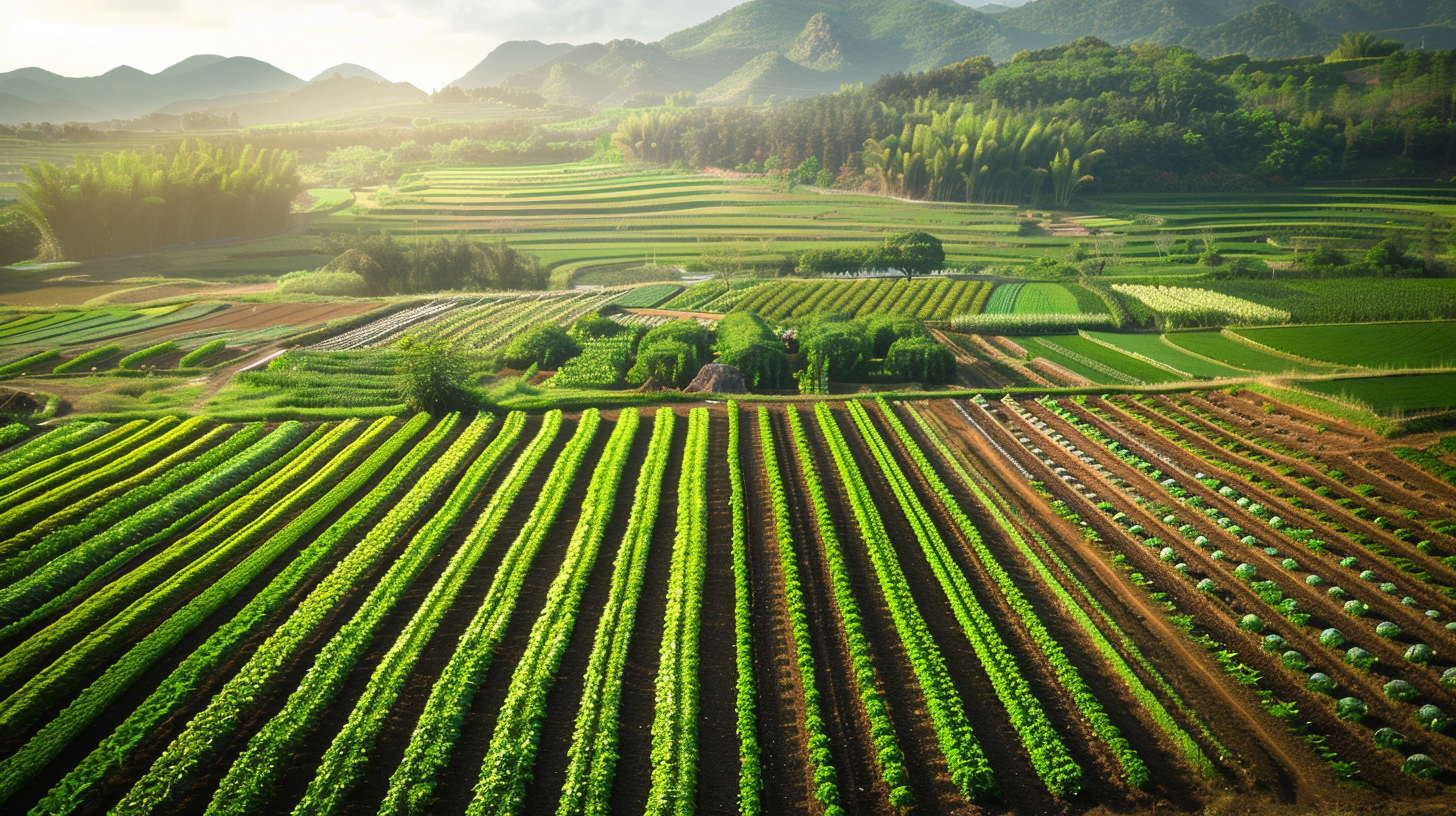Table of Contents Show
As we all know, agriculture’s only a tiny blip on the environmental radar, barely worth mentioning—until one considers its monumental impact on everything from water use to biodiversity loss. We’re here to peel back the layers of agriculture’s environmental footprint and explore sustainable farming methods that promise a greener future. Our journey will navigate through the complexities of soil health, water management, and the innovative technologies reshaping the way we farm. Join us as we uncover insights and strategies that could redefine our relationship with the land, leaving you wondering what lies within the kingdom of possibility for a sustainable agricultural system.
Key Takeaways
- Sustainable farming integrates techniques like crop rotation and organic practices to preserve soil health and biodiversity.
- Efficient water management strategies, such as drip irrigation and rainwater harvesting, are crucial to reduce water waste in agriculture.
- Implementing soil health and erosion management practices, including reduced tillage and cover cropping, enhances farm productivity and land sustainability.
- Pest control and pollution mitigation efforts, like Integrated Pest Management (IPM) and reducing chemical pesticide use, protect ecosystems and promote healthier farming environments.
The Role of Agriculture
Agriculture plays an essential role in sustaining human life by providing food, fiber, and raw materials. It’s the backbone of our existence, making sure we have enough to eat and materials for our daily needs. In our pursuit of freedom, it’s crucial we recognize how our farming practices impact the world around us. We’re at a crossroads, needing to balance our needs with the health of our planet.
We’re all about exploring and adopting methods that reduce our environmental footprint while maintaining, or even increasing, our agricultural output. Practices like crop rotation, organic farming, and the use of natural pest controllers are steps toward more sustainable agriculture. They not only help in preserving our soil and biodiversity but also ensure that we’re not tied down by the deteriorating health of our planet.
Additionally, integrating technology in agriculture, such as precision farming, can noticeably reduce waste and improve efficiency. It’s about working smarter, not harder, to produce more with less. This approach aligns with our desire for freedom, as it offers solutions that free up resources, time, and land.
We’re advocating for a shift towards methods that empower both the farmer and the consumer. By choosing sustainable practices, we’re not just securing our food supply; we’re ensuring that future generations have the freedom to thrive. It’s about taking responsibility now for a freer, more sustainable tomorrow. Together, we can forge a path that respects our planet’s limits while celebrating the abundance it offers.
Water Use and Management
Efficient water management is essential for sustainable farming, ensuring we use this precious resource wisely. We’re all about maximizing our freedom to farm effectively while respecting the earth’s natural limits. It’s not just about reducing our water use; it’s about innovating how we harness and apply every drop to nurture our crops.
We’ve embraced techniques that greatly reduce water waste. Drip irrigation, for instance, delivers water directly to the roots of plants, minimizing evaporation and runoff. It’s a game-changer, allowing us to use less water and still achieve bountiful harvests. Rainwater harvesting is another method we’re excited about. Capturing rainwater to irrigate our fields not only conserves water but also reduces our dependency on external sources, granting us more autonomy over our farming practices.
To give you a clearer picture, here’s a table showcasing some key strategies we employ in water management:
| Strategy | Benefit | Impact on Freedom |
|---|---|---|
| Drip irrigation | Reduces water waste | Increases self-reliance |
| Rainwater harvesting | Conserves water; reduces dependency | Enhances autonomy in water sourcing |
| Crop rotation | Improves soil moisture retention | Allows flexibility in farming practices |
These approaches empower us to make the most of every resource, reinforcing our commitment to sustainable farming. By managing water efficiently, we’re not just conserving it—we’re also upholding our freedom to cultivate our land responsibly and productively for generations to come.
Soil Health and Erosion
Turning our attention to soil health and erosion, we recognize their pivotal roles in sustainable farming. We’ll explore how improving soil composition and combating soil erosion are essential steps toward this goal. By focusing on these areas, we’re aiming for a more resilient and productive agricultural system.
Improving Soil Composition
Enhancing soil composition is essential for sustaining farm productivity and combating erosion. We’ve recognized that maintaining our freedom to farm effectively hinges on healthy soil. To achieve this, we focus on practices that improve soil health without restricting our ability to cultivate the land as we see fit. Here are four key methods:
- Incorporating Organic Matter: Adding compost or manure boosts soil fertility and structure.
- Cover Cropping: Planting cover crops enhances nutrient cycling and soil stability.
- Crop Rotation: Rotating crops prevents soil depletion and disrupts pest cycles.
- Reduced Tillage: Minimizing tillage preserves soil structure, reducing erosion risk.
Combating Soil Erosion
Building on our efforts to improve soil composition, we’ll now address how to effectively combat soil erosion, a key aspect of maintaining soil health. We’re embracing strategies that give us the freedom to cultivate our lands sustainably while safeguarding the environment. By integrating cover crops, we’re not just protecting the soil surface but also enhancing its structure and fertility. We’re adopting no-till farming, a revolutionary approach that reduces disturbance to the soil, preserving its integrity. We’re also constructing terraces on sloped lands, a method proven to reduce runoff and prevent erosion. Through these practices, we’re not only ensuring the longevity of our soil but also empowering ourselves to farm with respect for the earth, securing a sustainable future for all.
Pesticides and Pollution
We’re now turning our attention to the critical issue of pesticides and pollution, which poses a significant challenge to sustainable farming practices. We’ll explore how reducing pesticide usage and finding alternatives to chemical pesticides can mitigate environmental damage. It’s critical we address these strategies to guarantee the health of our ecosystems and the sustainability of agriculture.
Reducing Pesticide Usage
Reducing pesticide usage is essential to mitigating pollution and promoting healthier ecosystems. We’re all seeking freedom – from pollution, from degraded lands, and from the constraints of harmful agricultural practices. It’s about giving back to the earth that feeds us and ensuring our farming methods don’t imprison future generations in a cycle of environmental recovery.
Here are four key steps we can take:
- Implement Integrated Pest Management (IPM) strategies to reduce reliance on chemical solutions.
- Enhance biodiversity on farms to naturally control pest populations.
- Adopt crop rotation practices to disrupt pest life cycles.
- Educate farmers and agricultural workers on sustainable practices and the long-term benefits of reduced pesticide use.
Alternatives to Chemical Pesticides
Having explored ways to reduce pesticide usage, let’s now focus on alternatives to chemical pesticides for a healthier approach to farming. We’re all aiming for freedom in how we cultivate the land, and embracing natural pest control methods offers just that. By integrating biological controls, like beneficial insects that prey on pests, we’re not just eliminating harmful chemicals but boosting biodiversity. We’ve also got botanical pesticides, derived from plants, which are less toxic and often target specific pests, safeguarding other beneficial organisms. Additionally, adopting practices like crop rotation disrupts pest life cycles naturally. It’s clear we’ve got powerful tools at our disposal that align with nature’s rhythm, ensuring our farms thrive while protecting the environment. Let’s champion these sustainable alternatives and enjoy farming that respects our planet’s health and our desire for autonomy.
Biodiversity Loss
The loss of biodiversity greatly undermines the resilience and productivity of farming systems. As we embrace sustainable farming, we’re not just aiming to reduce our ecological footprint; we’re fighting for the guarantee to cultivate in harmony with nature. Biodiversity is the lifeblood of our food systems, providing pollination, pest control, and soil health. Without it, we’re at the mercy of synthetic solutions that often create more problems than they solve.
To combat biodiversity loss, we champion practices that bolster ecosystem health. Here are four critical strategies:
-
Crop Rotation: By rotating crops, we prevent the depletion of soil nutrients, breaking cycles of pests and diseases naturally.
-
Cover Cropping: Planting cover crops enriches the soil, protects against erosion, and fosters a diverse habitat for beneficial organisms.
-
Habitat Creation: We advocate for integrating natural habitats within farming landscapes. Hedgerows, flower strips, and ponds attract and sustain a rich variety of life.
-
Reduced Tillage: Minimizing soil disturbance preserves soil structure, encourages microbial activity, and reduces carbon emissions.
These strategies aren’t just about saving the planet; they’re about reclaiming our right to nourish ourselves and future generations without compromising the earth’s capacity to support life. By fostering biodiversity, we guarantee the resilience of our farming systems against the unpredictable challenges of climate and market fluctuations. It’s a path to freedom—freedom from dependency on harmful chemicals, freedom to produce healthy, sustainable food, and the freedom to thrive alongside nature, not at its expense.
Greenhouse Gas Emissions
While championing biodiversity lays the foundation for sustainable agriculture, we must also tackle the challenge of minimizing greenhouse gas emissions from farming activities. It’s essential we shift towards practices that respect our freedom to farm yet are kinder to our planet. By altering how we manage our land, livestock, and crops, we can notably reduce the carbon footprint of agriculture.
We’ve identified several strategies that are both effective and empowering for farmers. These include improving feed efficiency in livestock, adopting no-till farming, and enhancing soil carbon sequestration. Each method not only cuts down on emissions but also bolsters farm productivity and resilience.
Here’s a quick look at how these strategies stack up:
| Strategy | Benefit |
|---|---|
| Improving Feed Efficiency | Reduces methane emissions from ruminants. |
| Adopting No-Till Farming | Lowers CO2 emissions by retaining soil carbon. |
| Enhancing Soil Carbon Storage | Captures atmospheric CO2, enriching soil health. |
We believe in the power of choice and innovation. By adopting these strategies, we’re not just curbing emissions; we’re also paving the way for a more sustainable and independent agricultural future. It’s about making informed choices that align with our values of freedom and stewardship of the land.
Let’s embrace these changes, not as mandates, but as opportunities to lead in the fight against climate change. By acting now, we secure a healthier planet for future generations, ensuring that our farming practices continue to feed the world without costing the earth.
Deforestation and Agriculture
We’re now turning our attention to how agriculture contributes to deforestation, a critical issue that affects us all. We’ll explore the reasons behind agricultural deforestation, its impact on biodiversity, and how sustainable land management practices can mitigate these effects. It’s essential that we comprehend these aspects to promote healthier ecosystems and secure our food supply for the future.
Causes of Agricultural Deforestation
Agricultural expansion stands as a primary driver behind the widespread deforestation impacting various ecosystems worldwide. We’re facing a critical moment where our farming practices are clashing with the need for environmental preservation. To understand the root causes, let’s break it down:
- Demand for Farmland: Increasing global population requires more food, leading to the conversion of forests into agricultural lands.
- Cash Crops and Biofuels: The lucrative market for products like soy, palm oil, and biofuels encourages farmers to clear more land.
- Livestock Grazing: Vast areas are deforested to create pastures for cattle, affecting large swathes of land.
- Infrastructure Development: Roads and facilities to support farming activities often necessitate clearing forests.
We’ve got to find a balance, ensuring our freedom to farm doesn’t encroach on nature’s right to thrive.
Impact on Biodiversity
Having explored the causes of agricultural deforestation, it’s now imperative to examine how this practice drastically affects biodiversity. As we clear vast tracts of land for farming, we’re not just removing trees; we’re erasing entire ecosystems. This loss hits hard, not just on the species that lose their habitats, but also on the intricate web of life that supports our own existence. We’re talking about the pollinators essential for our food crops, the plants that purify our air, and the multitude of organisms that enrich the soil we depend on. It’s a chain reaction that diminishes nature’s resilience, making it harder for ecosystems to bounce back. We’re all about embracing freedom, but we’ve got to recognize that our actions have consequences that can chain our future to unsustainable paths.
Sustainable Land Management
In the face of deforestation and its impact on agriculture, it’s essential that we turn our focus toward sustainable land management strategies. We’re at a critical juncture where the choices we make can either further harm our planet or lead us toward a more sustainable and free future. To emphasize, here are four key strategies we must embrace:
- Adopt agroforestry practices that integrate trees and shrubs into agricultural landscapes.
- Implement crop rotation and diversification to improve soil health and reduce dependency on chemical inputs.
- Promote the use of cover crops to prevent soil erosion and enhance water retention.
- Encourage reduced tillage methods to maintain soil structure and biodiversity.
Crop Rotation Benefits
Often, crop rotation greatly enhances soil health, leading to more robust and sustainable agricultural practices. We’ve observed how rotating crops, rather than sticking to a single crop year after year, can notably reduce the need for synthetic fertilizers and pesticides. This method not only cuts down on costs but also minimizes our dependence on substances that are harmful to the environment. It’s a step towards freedom from the constraints of industrial farming methods, offering a path to independence for farmers and a healthier planet for all of us.
Here’s a quick glance at some of the benefits crop rotation brings to the table:
| Benefit | Description | Impact on Farming |
|---|---|---|
| Soil Fertility | Enhances nutrient balance by alternating crop demands. | Reduces need for chemical fertilizers. |
| Pest Reduction | Breaks the life cycle of pests specific to certain crops. | Lowers pesticide use. |
| Disease Control | Prevents the build-up of crop-specific diseases. | Improves crop health. |
| Weed Management | Suppresses weed growth through varied crop competition. | Decreases herbicide reliance. |
| Yield Improvement | Promotes healthier soil, leading to higher yields. | Boosts productivity and profitability. |
Embracing crop rotation is an expression of our desire for autonomy in farming. It’s about making choices that not only ensure our survival but also respect the earth. By adopting this practice, we’re not just farming; we’re cultivating freedom, resilience, and a legacy of stewardship for generations to come.
Organic Farming Practices
Why should we turn our attention to organic farming practices as the next step in sustainable agriculture? It’s a question we find ourselves asking as we look for ways to reduce our environmental footprint while still providing enough food for everyone. Organic farming holds the promise of a solution that respects the earth’s natural processes and, at the same time, guarantees that we’re not sacrificing our freedom to choose healthier and more sustainable options.
Organic farming practices emphasize the use of natural inputs and methods to manage soil fertility and control pests. This approach avoids synthetic pesticides and fertilizers, which can have harmful effects on our environment and health. Here are four key practices that illustrate why we should lean into organic farming:
- Crop Diversity: Planting a variety of crops improves soil health and reduces pests, reducing the need for chemical interventions.
- Composting: Using organic waste to enrich the soil enhances its fertility without synthetic fertilizers, keeping the soil alive and productive.
- Biological Pest Control: Encouraging beneficial insects and using natural predators instead of chemicals helps keep pest populations in check.
- Reduced Tillage: Minimizing soil disturbance helps maintain its structure and biodiversity, which is essential for soil health and carbon sequestration.
Agroforestry Integration
Building on the principles of organic farming, we now explore how agroforestry integration can further enhance sustainable agriculture practices. We’re diving into a domain where freedom meets farming, where the chains of traditional agriculture are broken, and we’re allowed to innovate, diversify, and sustain not just our crops, but our future.
Agroforestry, at its core, is the intentional integration of trees and shrubs into crop and livestock systems. It’s not just about planting trees among crops; it’s a strategic move towards biodiversity, soil enrichment, and ecosystem resilience. We’re talking about a farming revolution that respects the freedom of nature to regenerate and thrive.
Imagine a farm where rows of crops are interspersed with trees and shrubs, each element playing its part in a symphony of ecological balance. These trees aren’t just bystanders; they’re active participants in pest control, water conservation, and soil preservation. They’re the guardians of our crops, offering shade and shelter, reducing the need for chemical inputs, and ultimately, securing our freedom from dependence on unsustainable practices.
We’ve seen firsthand how integrating trees into farming systems can lead to healthier soils, increased yields, and more robust ecosystems. It’s a proof of the power of working with nature, rather than against it. As we embrace agroforestry, we’re not just adopting a set of practices; we’re championing a philosophy that values freedom, sustainability, and resilience.
In this journey towards sustainable agriculture, agroforestry isn’t just an option; it’s a necessity. It’s our path to freedom – freedom to grow, to innovate, and to sustain our world for generations to come.
Precision Agriculture Technologies
As we explore sustainable farming, we’re turning our attention to precision agriculture technologies. These innovative approaches, including smart sensing technology, GPS field mapping, and automated machinery integration, are revolutionizing how we manage and optimize farm operations. They offer precision and efficiency, greatly reducing waste and enhancing sustainability.
Smart Sensing Technology
Smart sensing technology revolutionizes precision agriculture by enabling farmers to monitor and manage their crops with unprecedented accuracy. We’re now equipped to make informed decisions that reduce waste and enhance crop yield. Here’s how we’re embracing freedom in farming:
- Tailoring water usage to the exact needs of each plant, conserving an essential resource.
- Optimizing fertilizer application to prevent overuse and reduce environmental impact.
- Detecting pests and diseases early, allowing for targeted intervention without blanket pesticide use.
- Monitoring plant growth and soil health in real-time, ensuring we can act swiftly to any changes.
This approach empowers us to produce more with less, championing sustainability while safeguarding our planet for future generations.
GPS Field Mapping
Having explored the benefits of smart sensing technology, we now turn our attention to GPS field mapping, another cornerstone of precision agriculture technologies. This method allows us to pinpoint the exact location, size, and productivity of our fields with remarkable accuracy. By embracing GPS field mapping, we’re not just mapping out land; we’re charting a course towards more sustainable farming practices. It enables us to apply fertilizers, water, and pesticides more efficiently, reducing waste and environmental impact. We’re also able to monitor crop health with precision, ensuring we intervene only when necessary. This approach not only conserves resources but also maximizes yields. It’s about making informed decisions that grant us the freedom to farm more responsibly and effectively.
Automated Machinery Integration
We’re now exploring the world of automated machinery integration, a pivotal aspect of precision agriculture technologies that revolutionizes how we farm by enhancing efficiency and sustainability. This leap towards automation grants us the freedom to manage our resources more effectively, ensuring that every drop of water and every grain of fertilizer is used to its utmost potential.
Consider the benefits:
- Reduced labor costs
- Increased crop yields
- Minimized environmental impact
- Precise application of inputs
Water Harvesting Techniques
Several water harvesting techniques can greatly enhance sustainable farming practices by conserving and utilizing rainwater more efficiently. We’re exploring ways to free ourselves from solely relying on unpredictable weather patterns and municipal water supplies. These methods not only reduce our dependency but also encourage a more responsible use of natural resources.
We’ve discovered that by implementing diverse water harvesting strategies, we can notably impact our water conservation efforts. Here’s a quick look at some effective techniques:
| Technique | Description |
|---|---|
| Rainwater Harvesting | Collecting and storing rainwater from roofs or surfaces for later use. |
| Check Dams | Small barriers built across the direction of water flow to catch and store rainwater. |
| Pond Systems | Excavated areas that collect and store rainwater, promoting groundwater recharge. |
| Contour Trenching | Digging trenches along the contour lines of hills to capture rainwater and reduce soil erosion. |
By incorporating these methods, we’re not just saving water; we’re taking a stand for our freedom to operate independently, ensuring our farms are less vulnerable to water scarcity. It’s about making a conscious choice to adopt practices that guarantee our operations remain sustainable and productive in the long run.
Embracing water harvesting doesn’t just benefit us today; it secures water for future generations, making sure they too have the freedom to cultivate and thrive. Let’s commit to these practices, ensuring our farming not only survives but flourishes in harmony with the environment.
Renewable Energy in Farming
Shifting to renewable energy sources revolutionizes the way farms operate, reducing our carbon footprint and promoting environmental sustainability. As we navigate through the challenges of climate change, it’s clear that we must adopt practices that not only benefit our farms but also the planet. Renewable energy in farming offers us the freedom to produce our own energy, lessen our reliance on fossil fuels, and build a more sustainable future for agriculture.
Integrating renewable energy sources into farming practices can seem intimidating, but the benefits far outweigh the initial hurdles. Here are four key renewable energy solutions we’re embracing:
- Solar Power: We’re installing solar panels on farm buildings and unused land to generate clean electricity. This not only powers our operations but also allows us to feed surplus energy back into the grid.
- Wind Turbines: For farms located in windy areas, wind turbines offer a fantastic way to harness natural energy. They’re becoming a common sight on the horizon, symbolizing our commitment to sustainability.
- Biomass Energy: We’re turning agricultural waste into energy. By using anaerobic digesters, we can convert manure and plant waste into biogas, which can be used for heating and electricity.
- Geothermal Systems: Utilizing the consistent temperature beneath the earth’s surface, geothermal systems can heat and cool farm buildings more efficiently than traditional methods.
Community Supported Agriculture
Community Supported Agriculture (CSA) offers a unique model for connecting farmers directly with their consumers, fostering a shared responsibility for the production of food. We’re talking about a system that not only bolsters local economies but also empowers us to make choices that resonate with our values of sustainability and community support. By participating in a CSA, we’re voting with our dollars for a food system that values environmental health, local resilience, and the freedom to choose where our food comes from.
In a CSA model, consumers purchase a share of the harvest upfront, which provides farmers the necessary capital at the start of the growing season. This setup reduces the financial risks for farmers and ensures consumers receive fresh, seasonal produce directly from a local source. It’s a win-win that nurtures our connection to the land and to each other.
Here’s a quick look at how CSAs can benefit both farmers and consumers:
| Benefits for Farmers | Benefits for Consumers |
|---|---|
| Steady income stream | Fresh, local produce |
| Reduced marketing costs | Connection to food source |
| Financial risk sharing | Support for local economy |
| Community engagement | Education on food seasons |
We’re not just buying vegetables or fruits; we’re investing in our local farms and, by extension, our community’s future. It’s about taking back control, ensuring our food doesn’t travel thousands of miles to reach our plates, and knowing the hands that have nurtured it. Joining a CSA means we’re part of a movement towards a more sustainable and equitable food system—a choice for freedom and responsibility.
Conclusion
We’ve explored various sustainable farming methods, from precision agriculture to renewable energy, and the importance of each cannot be overstated. One statistic that truly hits home is that about 52% of agricultural land is moderately or severely affected by soil degradation. This highlights the urgent need for adopting these sustainable practices. By embracing these methods, we’re not just securing food for our future generations; we’re healing our planet. It’s a responsibility we all share and a goal we can achieve together.








